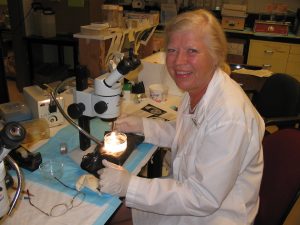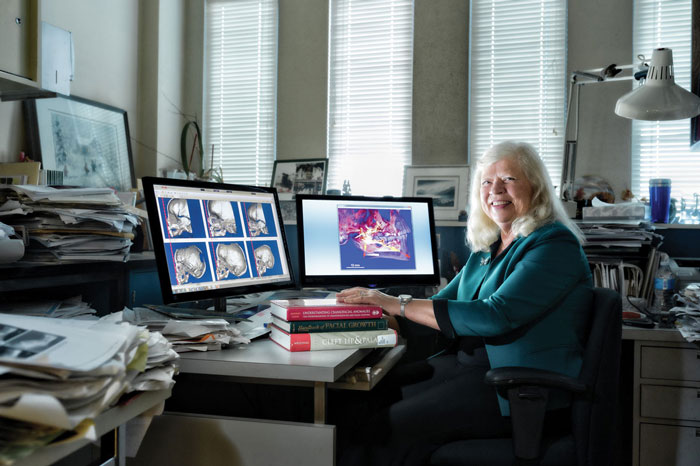2018-06-20
Dr. Virginia Medwid Diewert is retiring from teaching and administrative duties after many years of commendable performance and service.
Virginia Medwid Diewert, DDS, MSc, Cert Orthodont; Professor, Department of Oral Health Sciences (bio)
Connecting the Dots: Tracing the Remarkable Career of Dr. Virginia M. Diewert, Clinician Scientist
What makes a great academic? Someone who is a trail blazer and influencer beyond her immediate community. Dr. Virginia Medwid Diewert is just such a person. When there were almost no role models around, Virginia navigated the tough, male-dominated environments of dental school at the University of Alberta, orthodontics at Northwestern University, and in her field of craniofacial research at UBC in the Faculty of Dentistry.

Dr. Virginia M. Diewert at the refuge.
When Virginia was first hired at UBC in 1971, she encountered her first big challenge: there was no such thing as protected time for research. She was brimming with ideas for research projects and wrote her first successful application for a salary award from the Medical Research Council of Canada (predecessor to the Canadian Institutes of Health Research). This prestigious scholarship (probably the first given to an orthodontist) gave her five years to develop her ground-breaking research on cleft lip and palate. Simultaneously with establishing her lab, Virginia encountered her second big obstacle: the concept of maternity leave did not exist at the university. She was undeterred and raised two talented children with her supportive husband, Erwin Diewert (professor in Economics). The context is important here, while teaching, practicing orthodontics might be enough for some, yet Dr. Diewert was able to fund her lab continuously for 30 years. This achievement is even more impressive when you consider that grants had to be renewed every year in the 1970s and 1980s.
What set Virginia apart was her ability to think in 4D (3D development over time). She was a pioneer in computer-based 3D reconstruction and morphometric analysis (developed with her trainee Scott Lozanoff) back in the 1980s when computing power was miniscule. She elucidated the key, evolutionarily conserved, features between mice and humans. Virginia and Scott published the very first 3D morphometrics paper on embryonic facial growth in human as well as cleft and non-cleft mouse embryos. Together, Scott and Virginia created user-friendly software for use on desktop computers for 3D reconstructions. Virginia’s legacy has inspired many subsequent investigators to make craniofacial morphometrics part of their analyses, including her colleagues at UBC, Drs. Joy Richman and Sid Vora. Virginia has garnered respect from scientists around the world and her images have been reproduced internationally.
At UBC, she taught more than 40 classes of dentistry students who can credit their knowledge of growth and development to Virginia. She has directly influenced medical and dental teaching around the world. Throughout her career, Virginia has been an avid recruiter and supporter of new faculty and students, especially during her 13 years as department head of Oral Health Sciences. But this retirement is not the end, by any means. Virginia is very inspired by new developments in micro-CT imaging, something that was barely possible a decade ago. As she moves into an emeritus position at UBC, Virginia will continue to publish her unique insights into human embryonic and fetal growth with her colleagues at UBC and beyond.

Dr. Virginia M. Diewert in her office at the Faculty of Dentistry, University of British Columbia.